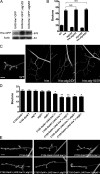Autophagy promotes synapse development in Drosophila
- PMID: 19786572
- PMCID: PMC2762098
- DOI: 10.1083/jcb.200907109
Autophagy promotes synapse development in Drosophila
Abstract
Autophagy, a lysosome-dependent degradation mechanism, mediates many biological processes, including cellular stress responses and neuroprotection. In this study, we demonstrate that autophagy positively regulates development of the Drosophila melanogaster larval neuromuscular junction (NMJ). Autophagy induces an NMJ overgrowth phenotype closely resembling that of highwire (hiw), an E3 ubiquitin ligase mutant. Moreover, like hiw, autophagy-induced NMJ overgrowth is suppressed by wallenda (wnd) and by a dominant-negative c-Jun NH(2)-terminal kinase (bsk(DN)). We show that autophagy promotes NMJ growth by reducing Hiw levels. Thus, autophagy and the ubiquitin-proteasome system converge in regulating synaptic development. Because autophagy is triggered in response to many environmental cues, our findings suggest that it is perfectly positioned to link environmental conditions with synaptic growth and plasticity.
Figures





Similar articles
-
DFsn collaborates with Highwire to down-regulate the Wallenda/DLK kinase and restrain synaptic terminal growth.Neural Dev. 2007 Aug 15;2:16. doi: 10.1186/1749-8104-2-16. Neural Dev. 2007. PMID: 17697379 Free PMC article.
-
Nibbling away at synaptic development.Autophagy. 2010 Jan;6(1):168-9. doi: 10.4161/auto.6.1.10625. Epub 2010 Jan 13. Autophagy. 2010. PMID: 20009548 Free PMC article.
-
Highwire restrains synaptic growth by attenuating a MAP kinase signal.Neuron. 2006 Jul 6;51(1):57-69. doi: 10.1016/j.neuron.2006.05.026. Neuron. 2006. PMID: 16815332
-
Development and plasticity of the Drosophila larval neuromuscular junction.Wiley Interdiscip Rev Dev Biol. 2013 Sep-Oct;2(5):647-70. doi: 10.1002/wdev.108. Epub 2013 Feb 5. Wiley Interdiscip Rev Dev Biol. 2013. PMID: 24014452 Free PMC article. Review.
-
Experimental methods for examining synaptic plasticity in Drosophila.Cold Spring Harb Protoc. 2012 Feb 1;2012(2):162-73. doi: 10.1101/pdb.top067785. Cold Spring Harb Protoc. 2012. PMID: 22301648 Review.
Cited by
-
Mechanisms of neuronal homeostasis: Autophagy in the axon.Brain Res. 2016 Oct 15;1649(Pt B):143-150. doi: 10.1016/j.brainres.2016.03.047. Epub 2016 Mar 30. Brain Res. 2016. PMID: 27038755 Free PMC article. Review.
-
Autophagy and ALS: mechanistic insights and therapeutic implications.Autophagy. 2022 Feb;18(2):254-282. doi: 10.1080/15548627.2021.1926656. Epub 2021 May 31. Autophagy. 2022. PMID: 34057020 Free PMC article. Review.
-
Regulation of presynaptic neurotransmission by macroautophagy.Neuron. 2012 Apr 26;74(2):277-84. doi: 10.1016/j.neuron.2012.02.020. Neuron. 2012. PMID: 22542182 Free PMC article.
-
Autophagy gets in on the regulatory act.J Mol Cell Biol. 2011 Apr;3(2):76-7. doi: 10.1093/jmcb/mjq033. Epub 2010 Oct 14. J Mol Cell Biol. 2011. PMID: 20947614 Free PMC article.
-
Differences in the Autophagy Response to Hypoxia in the Hippocampus and Neocortex of Rats.Int J Mol Sci. 2022 Jul 20;23(14):8002. doi: 10.3390/ijms23148002. Int J Mol Sci. 2022. PMID: 35887346 Free PMC article.
References
-
- Aberle H., Haghighi A.P., Fetter R.D., McCabe B.D., Magalhães T.R., Goodman C.S. 2002. wishful thinking encodes a BMP type II receptor that regulates synaptic growth in Drosophila.Neuron. 33:545–558 doi:10.1016/S0896-6273(02)00589-5 - DOI - PubMed
-
- Barcelo H., Stewart M.J. 2002. Altering Drosophila S6 kinase activity is consistent with a role for S6 kinase in growth.Genesis. 34:83–85 doi:10.1002/gene.10132 - DOI - PubMed
-
- Berry D.L., Baehrecke E.H. 2007. Growth arrest and autophagy are required for salivary gland cell degradation in Drosophila.Cell. 131:1137–1148 doi:10.1016/j.cell.2007.10.048 - DOI - PMC - PubMed
-
- Collins C.A., DiAntonio A. 2007. Synaptic development: insights from Drosophila.Curr. Opin. Neurobiol. 17:35–42 doi:10.1016/j.conb.2007.01.001 - DOI - PubMed
-
- Collins C.A., Wairkar Y.P., Johnson S.L., DiAntonio A. 2006. Highwire restrains synaptic growth by attenuating a MAP kinase signal.Neuron. 51:57–69 doi:10.1016/j.neuron.2006.05.026 - DOI - PubMed
Publication types
MeSH terms
Substances
Grants and funding
LinkOut - more resources
Full Text Sources
Molecular Biology Databases
Miscellaneous

